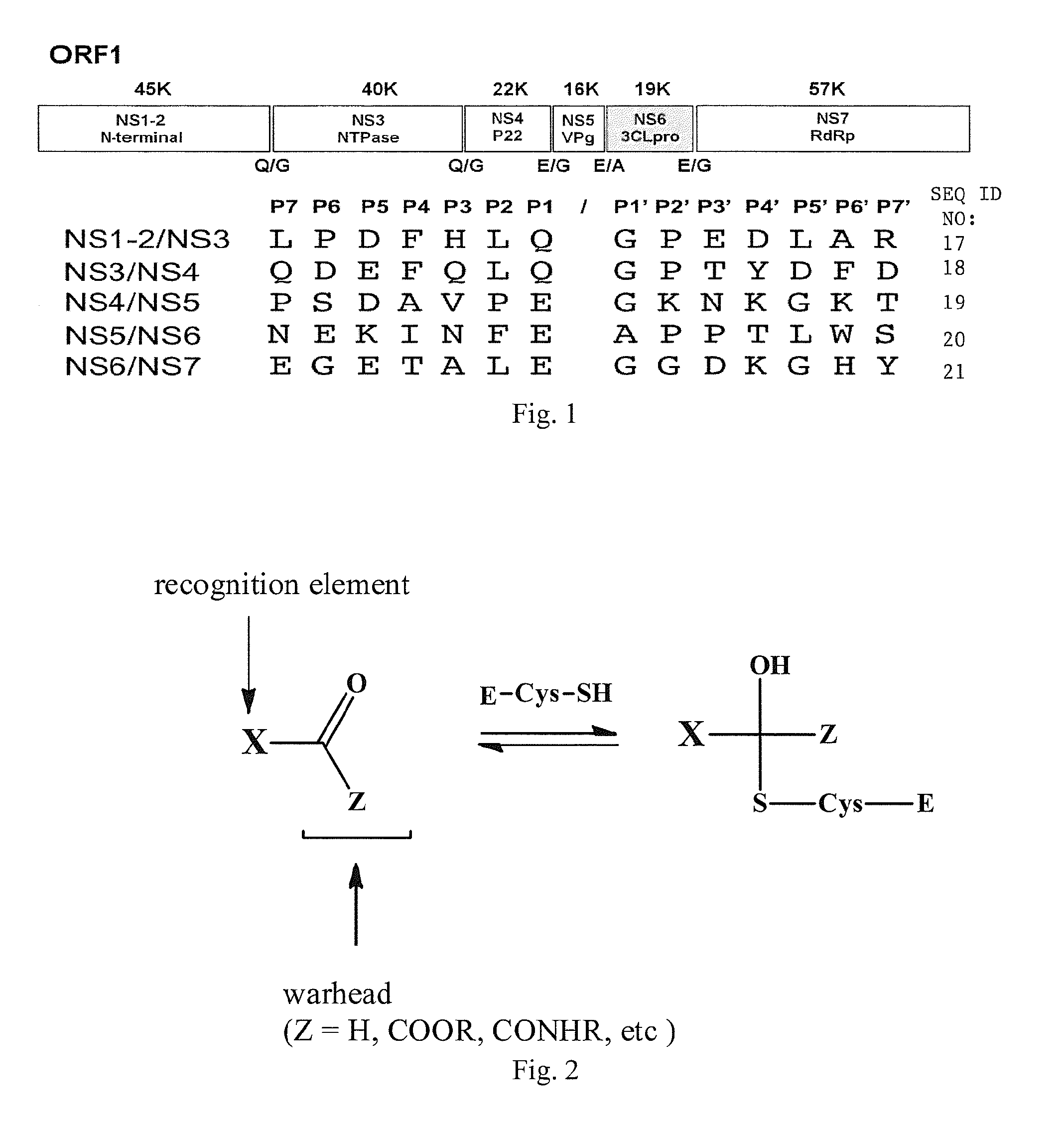Broad-spectrum antivirals against 3C or 3C-like proteases of picornavirus-like supercluster: picornaviruses, caliciviruses and coronaviruses
a supercluster and broad-spectrum technology, applied in the field of broad-spectrum antiviral compounds targeting the 3c or 3clike proteases of the picornaviruslike supercluster, can solve the problems of outbreaks in enclosed settings, rare broad-spectrum antivirals, and short specificity range, so as to prevent or inhibit the replication of a virus in a cell
- Summary
- Abstract
- Description
- Claims
- Application Information
AI Technical Summary
Benefits of technology
Problems solved by technology
Method used
Image
Examples
example 1
Design Synthesis and Evaluation of Inhibitors of Norwalk Virus 3C Protease
[0066]Noroviruses are a leading cause of food-borne and water-borne non-bacterial acute gastroenteritis. Norovirus infections constitute an important health problem with an estimated 23 million cases of gastroenteritis occurring annually in the U.S., causing 50,000 hospitalizations and 300 deaths. There are currently no effective vaccines or antiviral therapeutics for the treatment of norovirus infection.
[0067]Noroviruses are a small non-enveloped viruses of the Caliciviridae family. The genome of Norwalk virus, a prototype of noroviruses, consists of a single-stranded, positive sense RNA molecule of ˜7.7 Kilo bases) that consists of three open reading frames (ORFs) that encode a 200 kDa polyprotein (ORF1), a major capsid protein VP1 (ORF2), and a small basic protein VP2 (ORF3). The mature polyprotein is co- and post-translationally processed by a virus-encoded protease to generate mature non-structural protei...
example 2
Proteases Exhibiting Broad-Spectrum Activity Against Viruses that Belong to the Picornavirus-Like Supercluster
Materials and Methods:
[0077]1. Cells, viruses, and reagents. The various cell lines including HG23 cells (Huh-7, human hepatoma cells, containing NV replicon), CRFK (feline kidney cell line), RAW267.4 (murine monocytes / macrophages), ST (porcine testis cells), CCL-9.1 (murine hepatocytes), HRT18 (human colon cancer cells), MRC-5 (human lung fibroblast cells), FRhK-4 (monkey kidney cells), and Vero cells (monkey kidney cells) were maintained in Dulbecco's minimal essential medium (DMEM) or MEM containing 10% fetal bovine serum and antibiotics (chlortetracycline [25 μg / ml], penicillin [250 U / ml], and streptomycin [250 μg / ml]) (DMEM-C). Murine norovirus-1 was provided by Dr. H. Virgin (Washington University in St Louis, Mo.), and maintained in RAW267.4 cells. Viruses used in the study were feline calicivirus (FCV), murine norovirus (MNV-1), transmissible gastroenteritis virus (T...
example 3
Additional Study and Analysis of Viral Protease Inhibitors
[0155]In this Example: a FRET-based assay for norovirus 3CLpro is described; NV replicon-harboring cells have been established and the feasibility of using them for the discovery of potential antiviral therapeutics for norovirus infection has been demonstrated; initial series of peptidyl transition state (TS) inhibitors incorporating in their structure a glutamine surrogate have been designed (FIG. 8); and the inhibitory activities of the compounds have been investigated toward norovirus 3CLpro, as well as in NV replicon-harboring cells; the binding and detailed interactions, as well as the mechanism of action of NV 3CLpro with one of the compounds (GC376), were probed using X-ray crystallography and high-field NMR; three compounds were used to obtain a preliminary evaluation of their physicochemical properties using in vitro ADMET, rat PK and oral bioavailability; and finally, the effect of one of the inhibitors (GC376) on n...
PUM
| Property | Measurement | Unit |
|---|---|---|
| Δω | aaaaa | aaaaa |
| body weight | aaaaa | aaaaa |
| emission wavelength | aaaaa | aaaaa |
Abstract
Description
Claims
Application Information
 Login to View More
Login to View More - R&D
- Intellectual Property
- Life Sciences
- Materials
- Tech Scout
- Unparalleled Data Quality
- Higher Quality Content
- 60% Fewer Hallucinations
Browse by: Latest US Patents, China's latest patents, Technical Efficacy Thesaurus, Application Domain, Technology Topic, Popular Technical Reports.
© 2025 PatSnap. All rights reserved.Legal|Privacy policy|Modern Slavery Act Transparency Statement|Sitemap|About US| Contact US: help@patsnap.com



